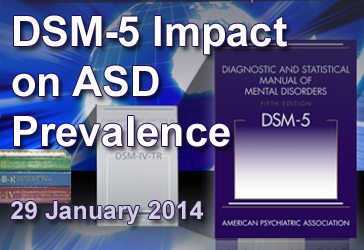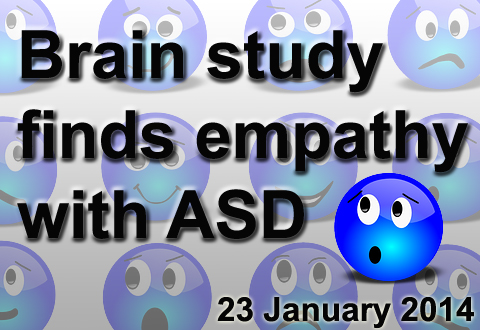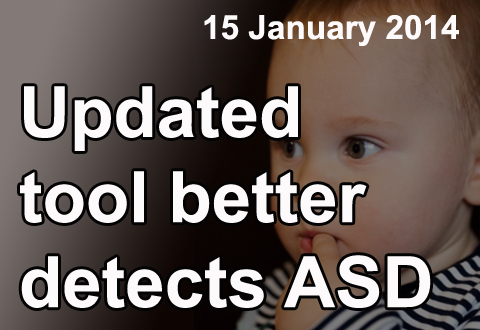Archives
January, 2014
Select a different month in the archive
DSM-5 Criteria May Reduce ASD Prevalence, Slightly
By Shana R. Spindler, Ph.D. on January 30, 2014

Background: On May 18, 2013, the American Psychiatric Association released the fifth edition of the Diagnostic and Statistical Manual of Mental Disorders (DSM-5), providing guidelines for mental disorder identification. The previous version, DSM-IV-TR, used a three-domain approach to diagnose autism, including criteria for social interaction, communication deficits, and repetitive or restrictive behaviors. In contrast, the DSM-5 measures two domains—social aspects and repetitive behavior. Moreover, DSM-5 focuses on the range of symptoms and severity under a single Autism Spectrum Disorder (ASD) compared to specific subtypes, such as Autistic Disorder and Asperger syndrome, outlined in DSM-IV. These controversial changes have led some to question if the new version will catch all autism cases, which ultimately affects autism prevalence rates as well as access to therapy.
What’s new: In a population-based study, a collection of United States researchers found that DSM-5 criteria likely captures about 81 percent of existing autism cases. The researchers analyzed patient records from the Autism and Developmental Disabilities Monitoring (ADDM) network, a large multi-site surveillance system in the United States.
Of the 644,883 records assessed, a total of 6,577 records showed an ASD diagnosis using DSM-IV-TR criteria. When the researchers applied DSM-5 criteria to those same records, only 5339 patients still had ASD. Children with regressive history or intellectual disability and children who had originally been diagnosed by a community professional were more likely to meet all DSM-5 requirements. Surprisingly, 304 of 1020 children received an ASD diagnosis with DSM-5 criteria after narrowly missing an autism diagnosis according to DSM-IV-TR guidelines.
Why it’s important: Unlike previous clinic-based studies, the current study used a population-based system to examine how DSM-5 will affect autism prevalence, hopefully providing a more accurate assessment. Given that as much as 19 percent of autism diagnoses may change with the DSM-5 criteria, future studies examining changes in autism prevalence will need to take this into account.
Help me understand :
| Source(s) : |
| Tweet |
Empathy For Others in Pain Present in ASD
By Shana R. Spindler, Ph.D. on January 23, 2014

Background: Empathy is the ability to understand what another person is feeling. The lack of this trait was thought to underlie some of the social problems present in people with Autism Spectrum Disorder (ASD). However, few studies have addressed the brain activity of those with ASD in situations where empathy would be likely.
What’s new: On January 14, 2014, the online journal Translational Psychiatry published a study that suggests people with ASD maintain the neural ability to process empathy, at least when seeing others in pain. Researchers used functional magnetic resonance imaging to examine the spontaneous brain activity of 38 adolescents and adults with high-functioning ASD and 35 age-matched controls as they watched two-second videos of people with shoulder pain.
Contrary to popular belief, the individuals with ASD showed no significant difference in spontaneous brain activity upon seeing someone in pain as compared to the control group. Both groups had activity in brain areas involving emotional arousal and understanding. At a lower statistical threshold, the group with ASD appeared to have increased activity in brain areas likely used for situation assessment.
Why it’s important: The researchers suggest that empathy remains intact in ASD, while the perceived lack of caring links to attempts to calm personal distress by reassessing the situation. The authors of the study note that pain is a very basic social cue and that future studies should look at additional situations where empathy is used.
Help me understand :
| Source(s) : |
| Tweet |
Updated Screening Tool Helps Provide Early ASD Diagnosis
By Chelsea E. Toledo, M.A. on January 15, 2014

Background: Early intervention has been shown to have positive outcomes for children with autism spectrum disorder (ASD). However, the disorder is typically diagnosed in children over the age of four, with an average age of diagnosis ranging from 38 to 120 months for all ASDs. During the last decade, researchers developed a screening assessment that could be administered at toddlers’ regular medical check-ups, with the aim of facilitating earlier diagnosis.
What’s new: On December 23, 2013, the journal Pediatrics published a study evaluating an updated version of that screening tool—called the Modified Checklist for Autism in Toddlers, Revised with Follow-up (M-CHAT-R/F). The researchers administered the 20-question checklist—which assessed children’s physical, social, and communicative habits—to parents of 16,071 children at their 18- and 24-month well-child care visits. Based on the responses, children were classified as low-, medium-, or high risk—with a follow-up questionnaire to refine the classification of those allocated to the medium-risk category. One percent of the children were ultimately deemed high-risk and were referred for further evaluation. Of those, 95 percent had confirmed developmental delays, and 47.5 percent received ASD diagnoses.
Why it’s important: From the results, the researchers concluded that the updated version of the M-CHAT is better at detecting ASD than its previous iteration. At the same time, the newer version of the screening tool classifies a smaller proportion of children as high- or medium-risk—reducing the number of families who would need to pursue follow-up testing.
Help me understand :
| Source(s) : |
| Tweet |
Blood Test Distinguishes Those with Autism
By Shana R. Spindler, Ph.D. on January 6, 2014

Background: Today, doctors diagnose Autism Spectrum Disorder (ASD) using behavioral evaluation, limiting how early in development a doctor can detect signs of autism. For this reason, researchers are looking for autism biomarkers, measurable features that are predictive of the disorder. One line of research investigates how much genes are turned on or off in the body. Called a “gene expression profile,” this particular measurement could distinguish children with ASD.
What’s new: Using DNA chip technology, researchers at Boston Children’s Hospital and Harvard Medical Center analyzed gene expression profiles in the blood cells of 20 pairs of siblings, in which only one sibling had ASD, and 18 unrelated control individuals. According to their study, 189 genes differed in expression between the affected and unaffected siblings. Surprisingly, a small group of the unaffected siblings had gene expression profiles that more closely matched the unrelated individuals than their own sibling. The genes that differed in expression are known to play a role in cell maintenance, energy production, neural signaling, immune response, and calcium signaling pathways.
Why it’s important: This study supports the idea that gene expression profiles may help predict if a child will develop autism. This has implications for early diagnosis, or at the very least, the identification of children that may need closer monitoring of developmental progress. Additional studies with larger sample sizes are needed to verify the study’s findings.
Help me understand :
| Source(s) : |
| Tweet |

